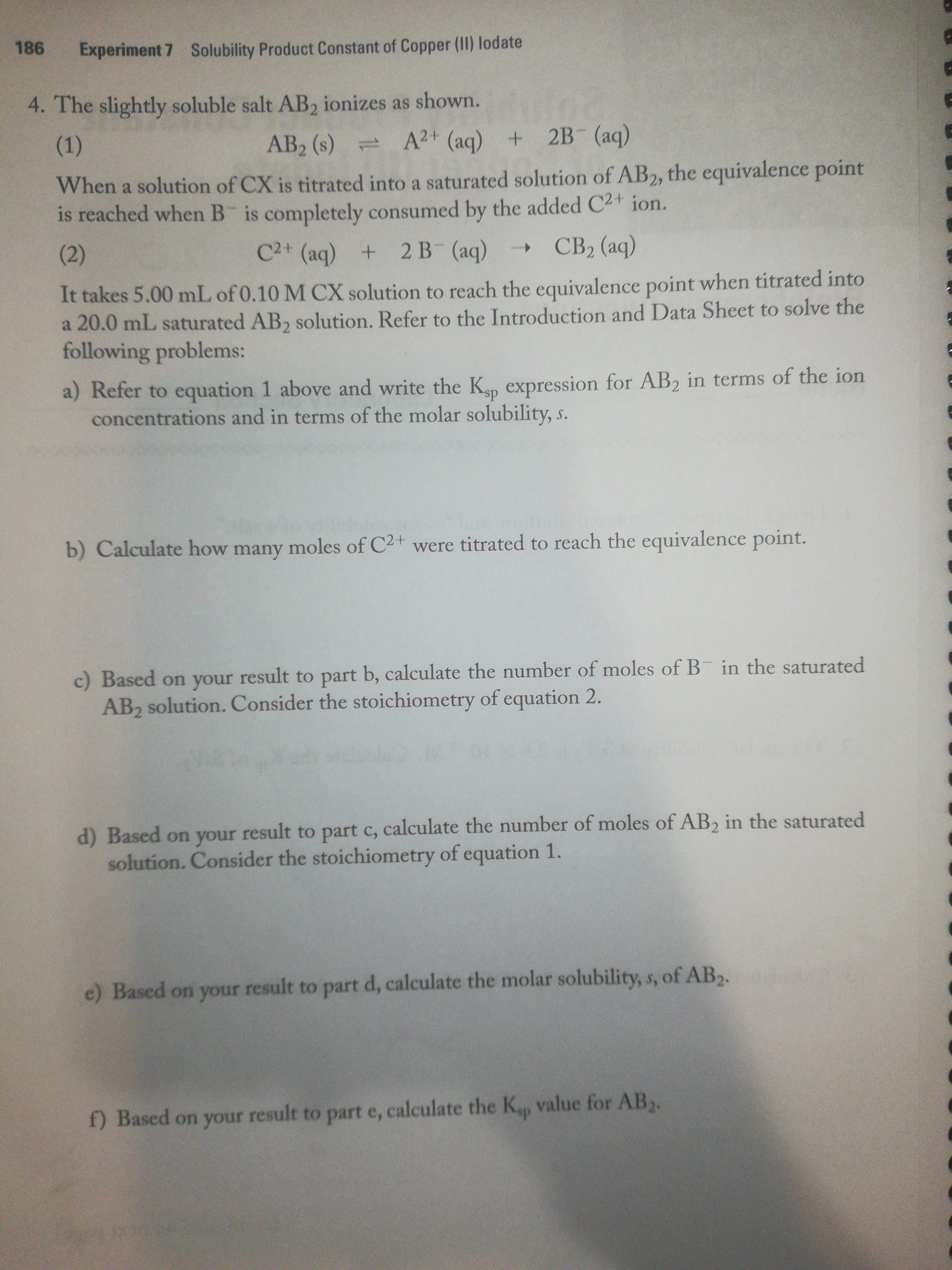186 Experiment 7 Solubility Product Constant of Copper (II) lodate 4. The slightly soluble salt AB, ionizes as shown. (1) AB2 (s) = A2+ (aq) + 2B (aq) When a solution of CX is titrated into a saturated solution of AB2, the equivalence point is reached when B is completely consumed by the added C2+ ion. (2) C2+ (aq) + 2 B (aq) • CB2 (aq) -> It takes 5.00 mL of 0.10 M CX solution to reach the equivalence point when titrated into a 20.0 mL saturated AB, solution. Refer to the Introduction and Data Sheet to solve the following problems: a) Refer to equation 1 above and write the Km expression for AB2 in terms of the ion concentrations and in terms of the molar solubility, s. b) Calculate how many moles of C2+ were titrated to reach the equivalence point. c) Based on your result to part b, calculate the number of moles of B in the saturated AB2 solution. Consider the stoichiometry of equation 2. d) Based on result to part c, calculate the number of moles of AB, in the saturated solution. Consider the stoichiometry of equation 1. your e) Based on your result to part d, calculate the molar solubility, s, of AB. f) Based on your result to part e, calculate the K value for AB.
186 Experiment 7 Solubility Product Constant of Copper (II) lodate 4. The slightly soluble salt AB, ionizes as shown. (1) AB2 (s) = A2+ (aq) + 2B (aq) When a solution of CX is titrated into a saturated solution of AB2, the equivalence point is reached when B is completely consumed by the added C2+ ion. (2) C2+ (aq) + 2 B (aq) • CB2 (aq) -> It takes 5.00 mL of 0.10 M CX solution to reach the equivalence point when titrated into a 20.0 mL saturated AB, solution. Refer to the Introduction and Data Sheet to solve the following problems: a) Refer to equation 1 above and write the Km expression for AB2 in terms of the ion concentrations and in terms of the molar solubility, s. b) Calculate how many moles of C2+ were titrated to reach the equivalence point. c) Based on your result to part b, calculate the number of moles of B in the saturated AB2 solution. Consider the stoichiometry of equation 2. d) Based on result to part c, calculate the number of moles of AB, in the saturated solution. Consider the stoichiometry of equation 1. your e) Based on your result to part d, calculate the molar solubility, s, of AB. f) Based on your result to part e, calculate the K value for AB.
Chemistry by OpenStax (2015-05-04)
1st Edition
ISBN:9781938168390
Author:Klaus Theopold, Richard H Langley, Paul Flowers, William R. Robinson, Mark Blaser
Publisher:Klaus Theopold, Richard H Langley, Paul Flowers, William R. Robinson, Mark Blaser
Chapter15: Equilibria Of Other Reaction Classes
Section: Chapter Questions
Problem 16E: Assuming that no equilibria other than dissolution are involved, calculate the concentration of all...
Related questions
Question
4a

Transcribed Image Text:186
Experiment 7 Solubility Product Constant of Copper (II) lodate
4. The slightly soluble salt AB, ionizes as shown.
(1)
AB2 (s) =
A2+ (aq) + 2B (aq)
When a solution of CX is titrated into a saturated solution of AB2, the equivalence point
is reached when B is completely consumed by the added C2+ ion.
(2)
C2+ (aq) + 2 B (aq)
• CB2 (aq)
->
It takes 5.00 mL of 0.10 M CX solution to reach the equivalence point when titrated into
a 20.0 mL saturated AB, solution. Refer to the Introduction and Data Sheet to solve the
following problems:
a) Refer to equation 1 above and write the Km expression for AB2 in terms of the ion
concentrations and in terms of the molar solubility, s.
b) Calculate how many moles of C2+ were titrated to reach the equivalence point.
c) Based on your result to part b, calculate the number of moles of B in the saturated
AB2 solution. Consider the stoichiometry of equation 2.
d) Based on result to part c, calculate the number of moles of AB, in the saturated
solution. Consider the stoichiometry of equation 1.
your
e) Based on your result to part d, calculate the molar solubility, s, of AB.
f) Based on your result to part e, calculate the K value for AB.
Expert Solution
This question has been solved!
Explore an expertly crafted, step-by-step solution for a thorough understanding of key concepts.
This is a popular solution!
Trending now
This is a popular solution!
Step by step
Solved in 3 steps with 3 images

Knowledge Booster
Learn more about
Need a deep-dive on the concept behind this application? Look no further. Learn more about this topic, chemistry and related others by exploring similar questions and additional content below.Recommended textbooks for you

Chemistry by OpenStax (2015-05-04)
Chemistry
ISBN:
9781938168390
Author:
Klaus Theopold, Richard H Langley, Paul Flowers, William R. Robinson, Mark Blaser
Publisher:
OpenStax

Chemistry for Engineering Students
Chemistry
ISBN:
9781337398909
Author:
Lawrence S. Brown, Tom Holme
Publisher:
Cengage Learning

Chemistry: Principles and Practice
Chemistry
ISBN:
9780534420123
Author:
Daniel L. Reger, Scott R. Goode, David W. Ball, Edward Mercer
Publisher:
Cengage Learning

Chemistry by OpenStax (2015-05-04)
Chemistry
ISBN:
9781938168390
Author:
Klaus Theopold, Richard H Langley, Paul Flowers, William R. Robinson, Mark Blaser
Publisher:
OpenStax

Chemistry for Engineering Students
Chemistry
ISBN:
9781337398909
Author:
Lawrence S. Brown, Tom Holme
Publisher:
Cengage Learning

Chemistry: Principles and Practice
Chemistry
ISBN:
9780534420123
Author:
Daniel L. Reger, Scott R. Goode, David W. Ball, Edward Mercer
Publisher:
Cengage Learning

Chemistry: Principles and Reactions
Chemistry
ISBN:
9781305079373
Author:
William L. Masterton, Cecile N. Hurley
Publisher:
Cengage Learning

Chemistry: An Atoms First Approach
Chemistry
ISBN:
9781305079243
Author:
Steven S. Zumdahl, Susan A. Zumdahl
Publisher:
Cengage Learning

Chemistry
Chemistry
ISBN:
9781305957404
Author:
Steven S. Zumdahl, Susan A. Zumdahl, Donald J. DeCoste
Publisher:
Cengage Learning